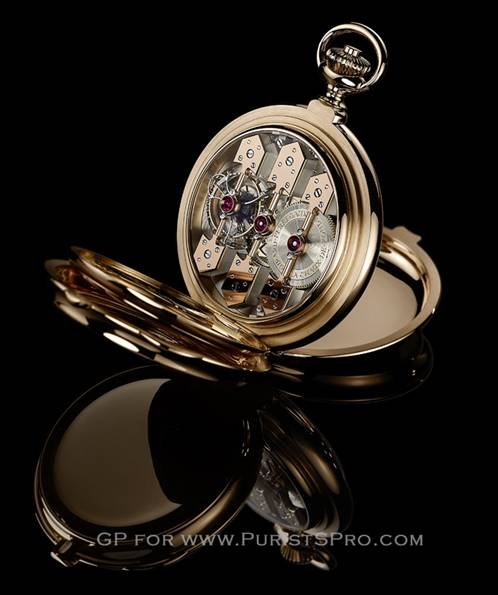
Girard-Perregaux Tourbillon with Triple Gold Bridges Pocket Watch

Since its invention in the 18th Century, the Tourbillon has been a constant source of fascination: it is without doubt the most famous watchmaking invention of all time.
Girard-Perregaux, with a wealth of history dating back to 1791, is one of the Firms that have made a major contribution to the development of the Tourbillon. Constant Girard-Perregaux, the master watchmaker who gave the Manufacture his name, devoted a great deal of research to the Tourbillon, and to him we owe one of the most famous watches of Swiss Haute Horlogerie: the Tourbillon with three gold Bridges, which was awarded a gold medal at the Paris Universal Exhibition in 1889.
GIRARD-PERREGAUX TOURBILLON WITH THREE GOLD BRIDGES POCKET WATCH
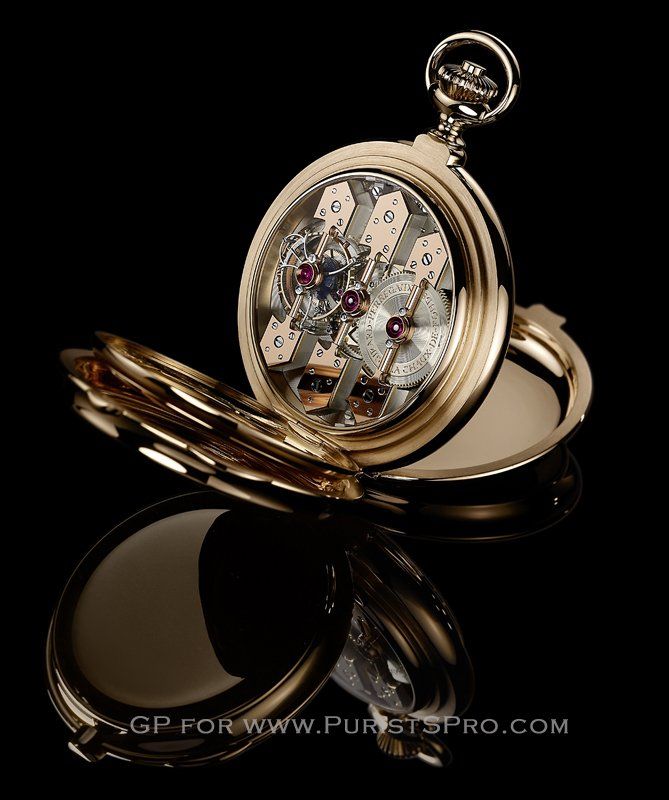
INTRODUCTION
In total, over sixty Tourbillons were produced until the 1910s, before production was halted. It was not until the end of the 1970s that Girard-Perregaux's watchmakers took up the challenge of producing remakes of Constant Girard-Perregaux's prizewinning watch. The whole difficulty lay in remaking a watch when all the watchmaking expertise and skills had been forgotten. After over 1500 hours' work, the first piece was presented in 1982, winning universal admiration. However not all of the 20-piece series of watches originally planned were produced at the time...
Now, Girard-Perregaux has decided to revive the legend. Though it has been over ten years since the last piece was produced, the components and plans have always been available. Hence the Manufacture has undertaken the creation of a new pocket watch, a replica of the 1889 version. The fruit of over one year's work by a highly talented watchmaker, this spectacular piece takes us on a journey through time to discover the fascination of Swiss Haute Horlogerie.
PRINCIPLE OF THE TOURBILLON AND HISTORY
Since the 18th Century, the quest for watch accuracy has been the focus of watchmakers' full attention.
With the development of long-haul travel, seafarers needed their timepieces to be as accurate as possible, since they were necessary for determining their position at sea. While it was easy to find the latitude, determining the longitude required the use of highly accurate marine chronometers.
It was already known at this time that gravity had an adverse effect on the rate of pocket watches, which were always in the vertical position when worn. To compensate for this effect, Abraham Louis Breguet had the idea of placing the regulating part of the watch (balance-spring-escapement assembly) in a "cage" turning on its own axis. This achieved mixed vertical positions, ensuring a highly regular average rate, and thereby extreme accuracy, eliminating the watch's sensitivity to gravity.
After its invention in 1801, the interest in the Tourbillon emerged around the middle of the 19th century, for two main reasons:
§ The growing fascination for international exhibitions and world fairs and the competitions they held
§ The birth of an Observatory in Neuchâtel (1858) for Swiss watchmakers. This period coincided with the industrialization of watchmaking, which till then had been a cottage trade
An excellent watchmaker Constant Girard-Perregaux took an interest in the Tourbillon. Initially, like most other watchmakers, he used standard movements and grafted on his Tourbillon. He did so remarkably that one of his watches presented in 1867 at the Neuchâtel Observatory and held a precision record for as long as 17 years.
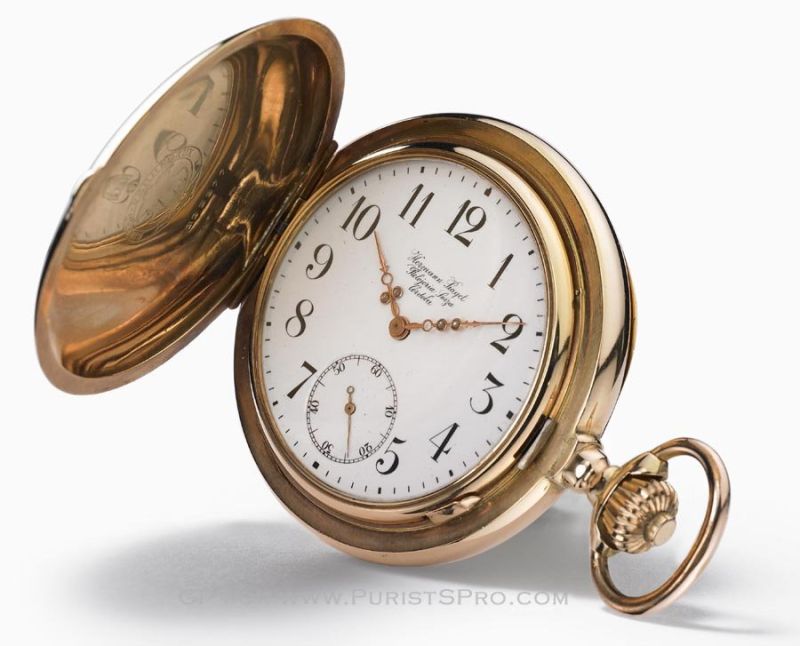
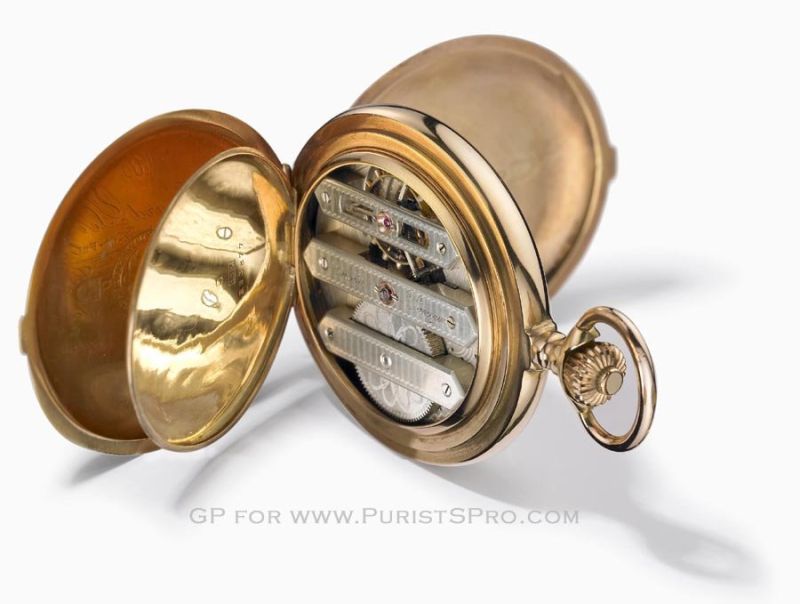
Tourbillon with three nickel Bridges, which held a precision record for as long as 17 years, 1867
Constant Girard then focused on those elements ignored by its contemporaries: the structure of the movement and the shape of its parts, which are true recognition elements.
It took around Constant Girard decades of research and development to perfect the architecture of his movement with three gold bridges, the design of which he patented in March 1884.
On September 29, 1889 the famous Tourbillon with three gold Bridges, Constant Girard's masterpiece and the fruit of many years' labour, was awarded a gold medal at the Universal Exhibition in Paris.
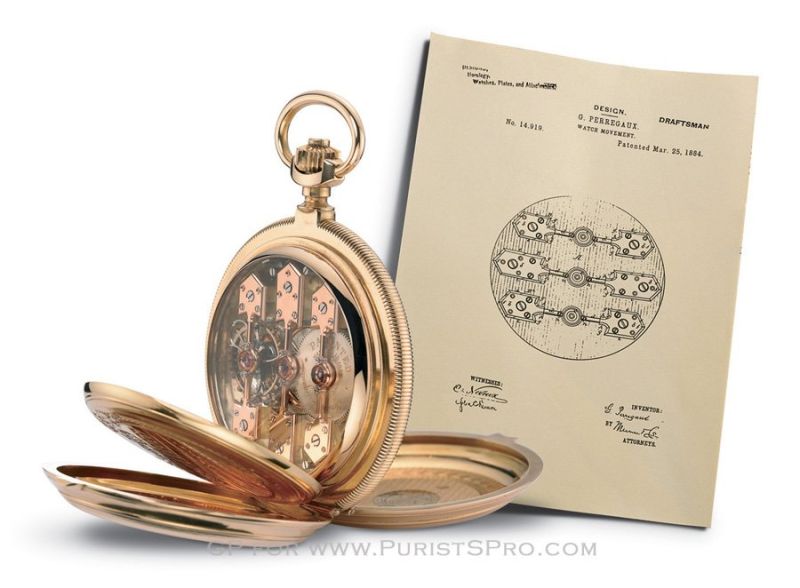
Patent for a movement with three gold Bridges, 1884. Tourbillon with three gold Bridges awarded a gold medal at the Universal Exhibition in Paris, 1889
In 1900, Constant Girard was judged ineligible to present his own watches at universal exhibitions competitions because his Tourbillon was considered beyond match. He would be appointed a permanent jury member of the most popular international exhibitions in recognition of its achievements!
All in all, Girard-Perregaux registered 57 Tourbillons with the Observatory of Neuchâtel, 24 of them with three gold Bridges. Four of them won prizes, the last in 1911, which means that the Tourbillons continued to be manufactured for the eight years after Constant Girard's death.
Several generations of watchmakers later, at the height of the Swiss watch industry's crisis, under siege by the competition from quartz, certain brands decided to react by re-launching the development of high-grade mechanical watches.
At that time, Girard-Perregaux began to produce 20 replicas of the original Tourbillon with three gold Bridges from 1889. It was necessary to re-learn how to make the elements that had meanwhile disappeared, and manage processes long since forgotten. In 1982, after almost 1,500 hours of work, the first piece emerged and attracted the highest of praise.
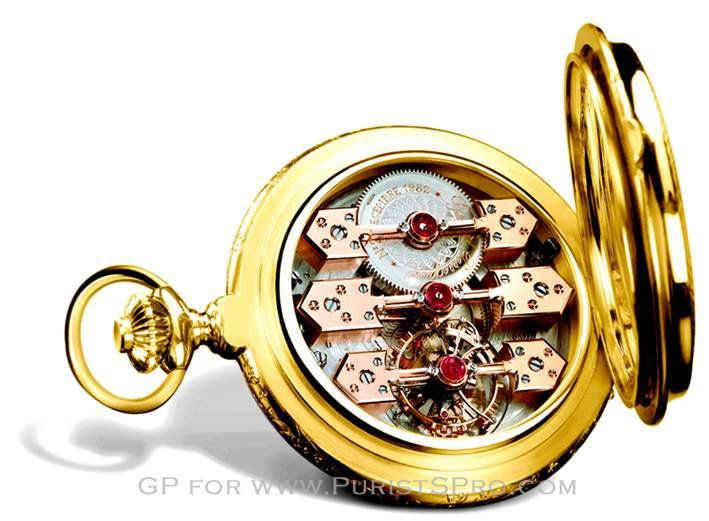
Tourbillon with three gold Bridges, 1982, first re-edition of the pocket watch from 1889
TOURBILLON WITH THREE GOLD BRIDGES – TECHNICAL FEATURES
The ambition of Manufacture Girard-Perregaux, in its decision to produce a new remake of Constant Girard-Perregaux's famous 1889 Tourbillon with three gold Bridges, is to bring the legend back to life.
The last Tourbillon with three gold Bridges of the 20-piece series reproducing the 1889 pocket watch was released from the Girard-Perregaux workshops more than ten years ago. However, not all the watches had been produced. Hence the Manufacture had the rough components and plans to create new pieces.
Pulling off this feat called on over one year's complete commitment by a watchmaker, in which he had to relearn the forgotten skills, techniques and expertise to achieve a reproduction of this exceptional piece with the same level of perfection.
TOURBILLON CAGE WITH BIMETAL GUILLAUME BALANCE
The shape of the Tourbillon with three gold Bridges cage is a genuine hallmark of the Brand. Girard-Perregaux, one of the Haute Horlogerie Manufactures with the richest tradition and greatest legitimacy in creating Tourbillons, is among the few Firms with its own form of cage: the Perregaux cage. Created by Constant Girard-Perregaux circa 1880, it exhibits a characteristic lyre shape.
Since the Tourbillon cage of the pocket watch comprises 92 components, it is easy to imagine the feat of skill involved in its creation, its numerous finishes, its assembly and setting.
The balancing, adjustments, settings and tests on the bimetal Guillaume balance are highly delicate operations, which require several weeks' work in their own right.
The initial step consists in cutting the balance rim at two section points. The balance then needs to be adjusted to be perfectly round and flat, to ensure optimum setting under all conditions.
The temperature adjustment and balancing of the balance are the result of a host of long practical tests, since only perfect balancing can achieve an accurate and stable rate. To do so, the watchmaker moves and adjusts the gold compensation screws so that the balance always retains its equilibrium, regardless of temperature variations that cause expansion/contraction of the rim.
The balance spring contracts or expands under the effect of temperature variations. To compensate for the resulting rate errors, the Tourbillon with three gold Bridges is equipped with a bimetal Guillaume balance, as was the practice on the highest quality watches in the 19th Century.
The balance rim comprises a brass outer with anibal (an alloy of steel and nickel) and steel on the inner, and is cut between each arm. When the temperature falls, the rim opens; when the temperature rises, it closes. Hence the moment of inertia is modified, to compensate for variations due to expansion of the balance spring.
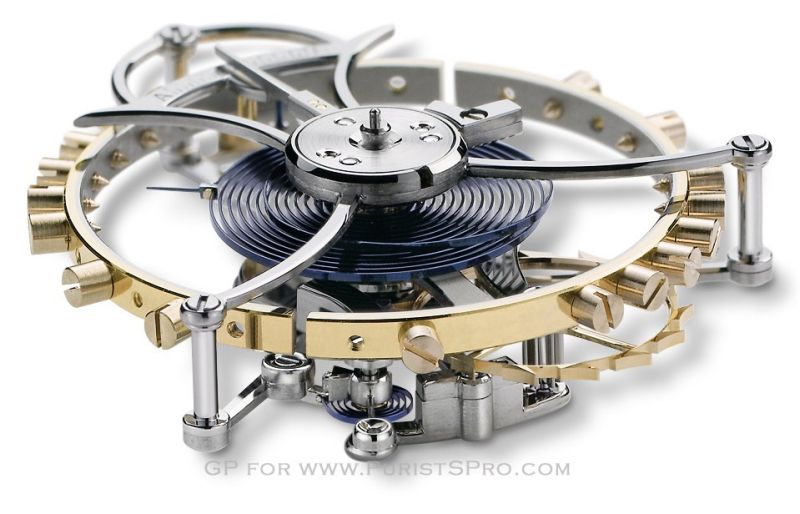
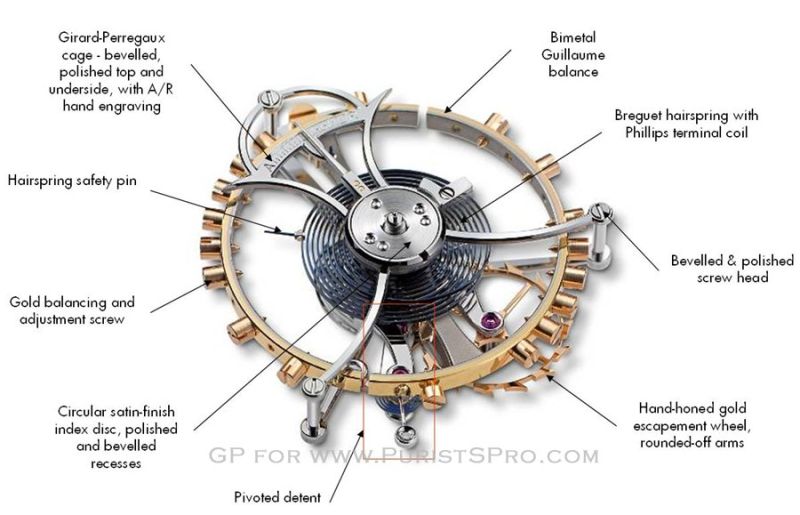
PIVOTED DETENT ESCAPEMENT
From the 18th Century onwards, accuracy was the most important quality criterion for watches.
In this context, watchmakers developed new types of escapements, including the detent escapement, which provided a considerable improvement in accuracy. Though being very difficult to make, taking a long time to adjust and relatively sensitive to impacts, detent escapements, which are part of the "free" escapements family and do not require lubrication, are now among the most accurate escapements. That is why Constant Girard-Perregaux opted for a detent escapement, a genuine technical feat, to be fitted in his Tourbillon with three gold Bridges. This escapement, a genuine hallmark of the piece, is recognisable without even looking at the movement: indeed, the watch has a characteristic sound, with a loud "tick" followed by a quiet "tock".
True to the great tradition of Girard-Perregaux pocket watches of the 19th Century, this Tourbillon with three gold Bridges is equipped with a so-called pivoted detent escapement, the shape of which is unique to Girard-Perregaux. The detent is mounted on pivots and a hairspring attached to the stud holds the detent in position, slightly resisting its release. Here, a counterpoise balances the detent.
For a detailed explanation of the functioning of the detent escapement, please refer to the excellent clockwatch.de website:
http://www.clockwatch.de/index.html?html/tec/hem/chf.htm
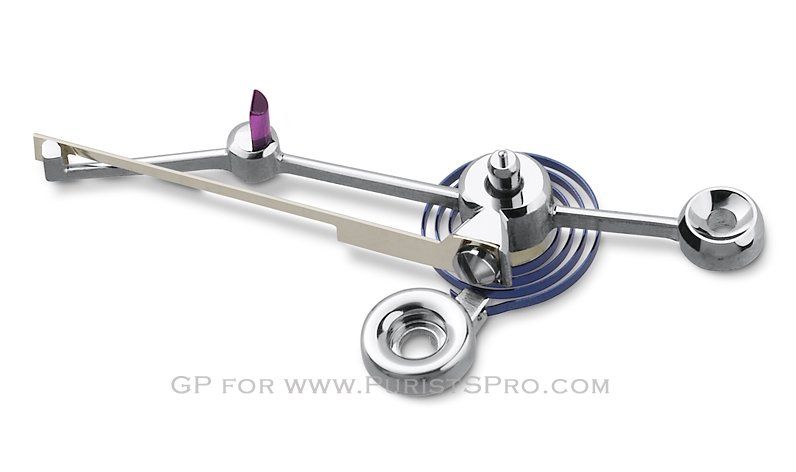
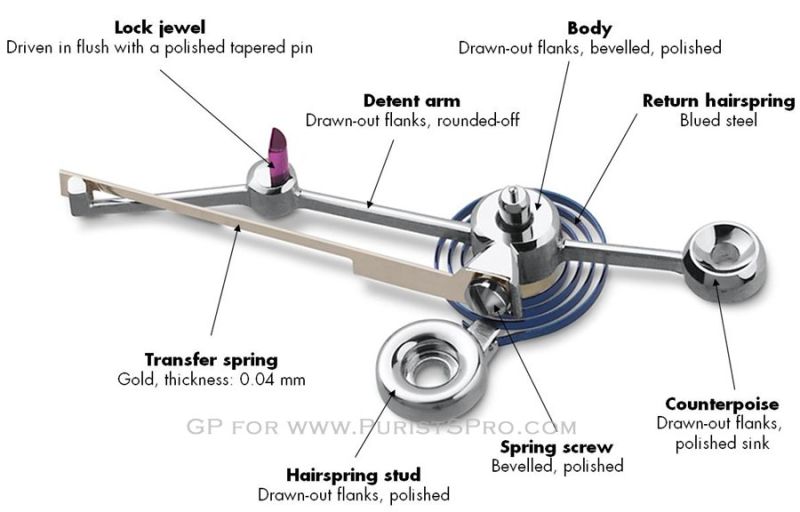
ANTI-TRIPPING SAFETY PIN
In order to guarantee optimum rate accuracy, the detent escapement has a highly uncommon and extremely hard to make safety system: an anti-tripping pin placed on the hairspring.
A detent escapement watch starts to "trip" when the balance over-rotates, for example due to an impact, and releases the detent a second time, i.e. when a single balance oscillation releases two teeth on the escapement wheel, and therefore moves the small seconds hand forward by two seconds instead of one.
To prevent this phenomenon, a pin is fashioned from a small steel bar and then threaded onto and fastened on the hairspring to prevent the detent from being released a second time. Since this pin measures 1.85 mm in length with a diameter of 0.07 mm, we can imagine the difficulty of making this part and positioning it with great accuracy on the balance to ensure that the safety system works.
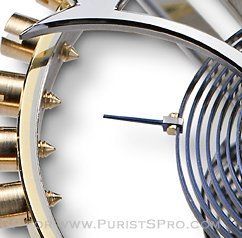
BARREL WITH MALTESE CROSS
In the quest for optimum rate accuracy, the barrel is equipped with a subtle piece of technology: a Maltese Cross stop work system.
The power of the spring is not released in linear fashion: it is has a lot of power when fully tensed, and very little when nearly slack (see diagram on left). Since the power from the barrel is not constant, the amplitude of the balance is not constant either, which can affect the watch rate.
To limit this effect, the range of use of the barrel spring is deliberately limited. Thanks to a Maltese Cross stop work system, use of the first and last coils of the mainspring is locked, and only the range where the spring power is most constant is used. Though this slightly reduces the power reserve, the accuracy is greatly improved throughout the watch's working life.
TOURBILLON WITH THREE GOLD BRIDGES – EXCEPTIONAL FINISHES
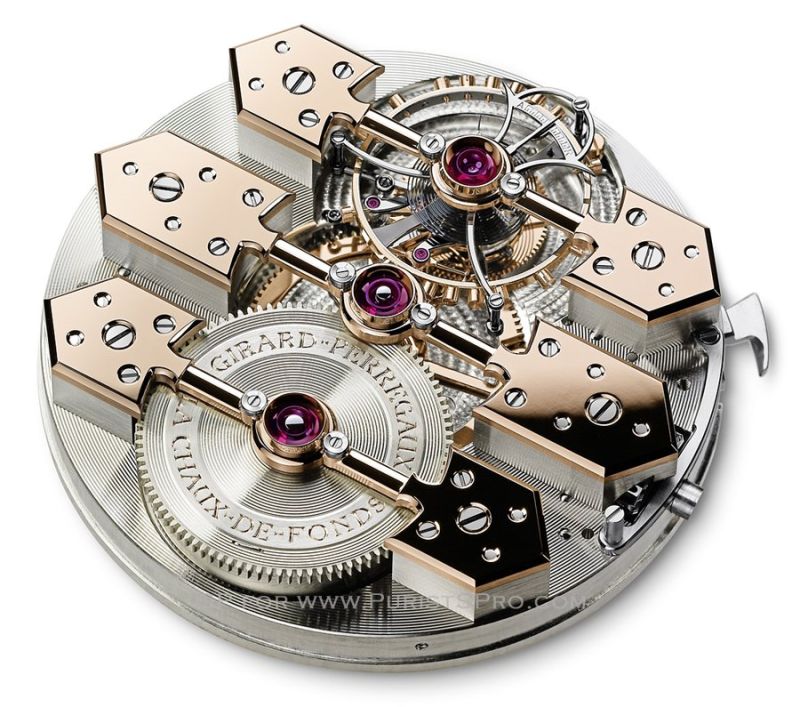
The incredible beauty of the Tourbillon with three gold Bridges is the sum of a host of details which make it a unique piece. Each movement component is hand finished and decorated by craftsmen expert in their field.
On the finished movement opposite we can instantly recognise the iconic architecture of the three bridges holding the Tourbillon, the gear train and barrel. The nickel silver main plate is guilloche worked with a snail finish (spiral groove around the main plate).
The bridges, centrepieces of the movement, are the focus of all attention to achieve an exceptional finish: obtaining a perfect result on them has taken over one month's work.
The surface of the bridge is polished, while all the edges and screw recesses are hand-bevelled. We can note that each bridge has four inward corners between the arm and arrow, which are particularly difficult to achieve.
The great particularity of these bridges is the rounded-off finish of the bridge arms. Rounding-off, completely impossible to achieve with a machine, consists in obtaining a domed surface in an arc, rather than flat.
This highly uncommon finish requires exceptional dexterity and concentration to obtain a perfectly regular semi-circle over the entire length. Any imperfection would be immediately made visible by reflected light.
An additional difficulty lies in the movement comprising three bridges, which means that they must be perfectly uniform and all the surfaces exactly parallel.
As a mark of the highest quality that also contributes greatly to the beauty of the movement, a screw-in gold setting is mounted on each bridge to hold the jewel.
The particularity of the settings on the bridges on the Tourbillon with three gold Bridges is that they are held by means of two thin steel washers, rather than directly by screws as is usually the case, making for an even more refined look.
The setting, washers and screw heads are mirror-polished.
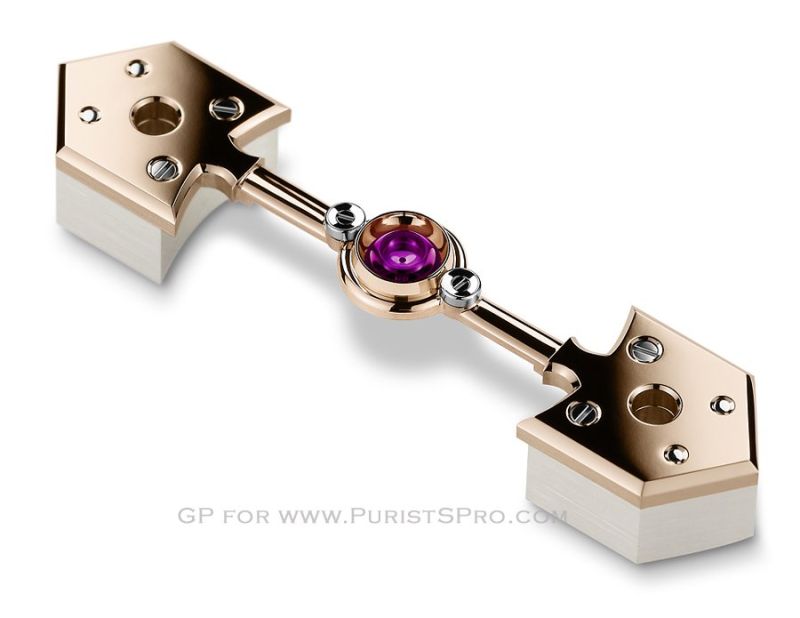
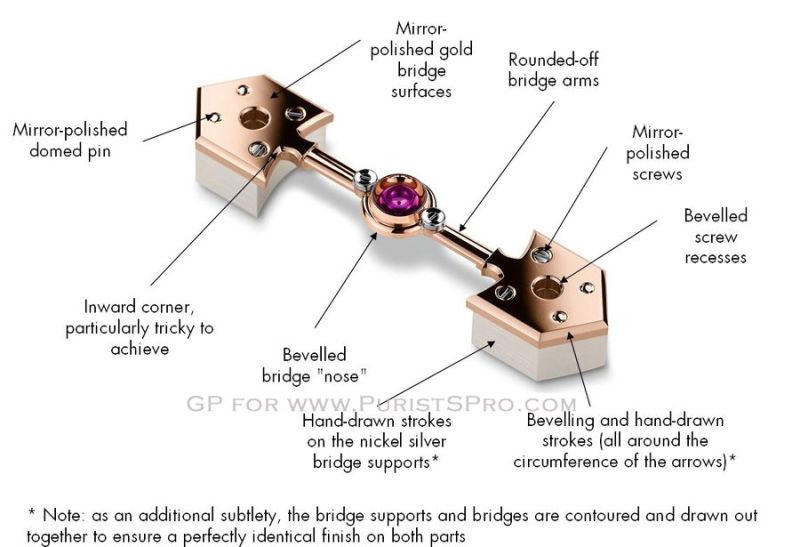
All the components are decorated with the same care, whether or not they are visible - a mark of exceptional quality movements. Here for example are the finishes applied to the nickel silver main plate situated under the watch dial, which can therefore only be seen by the watchmakers working on them.
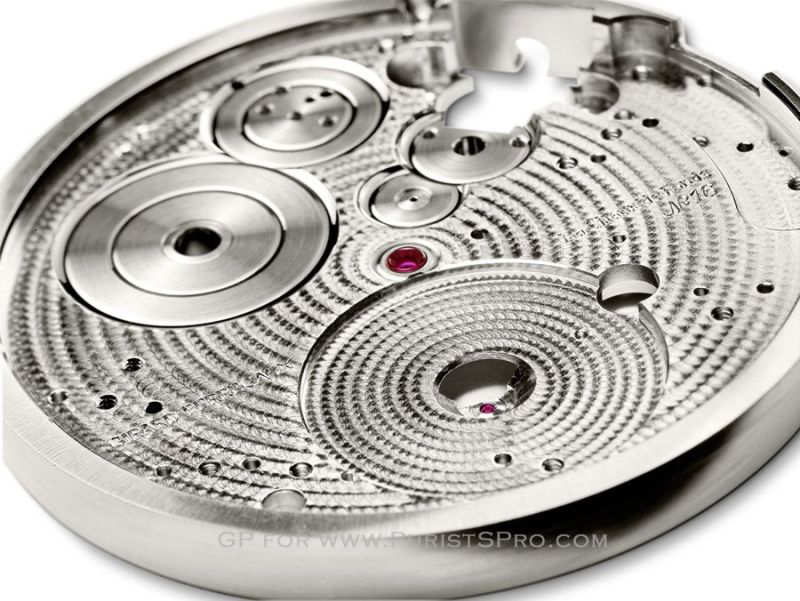
SETTING AND ASSEMBLY
Before they can be assembled, each of the movement's 249 components must be corrected by hand. These operations, which require a great deal of time and manual precision are essential for adjusting components to each other and ensuring perfect operation.
Hence the watch is first "rough" assembled, i.e. without the components being decorated to validate operation before complete disassembly for decoration, followed by reassembly with the finalised components.
Assembly is a crucial moment as it is extremely delicate: one false move could damage the components that have required hundreds of hours' work. Here is an example of the care taken with handling: to screw the bridges onto the main plate, the watchmaker uses wooden pegs rather than metal screwdrivers that might scratch the bridge.
In addition, the watch is set for optimum rate accuracy, which again requires a lot of time and tests. The watch rate must be as constant as possible in every position and at every temperature. Any modification must be made with the greatest intricacy so that when one parameter is modified, the others are not affected.
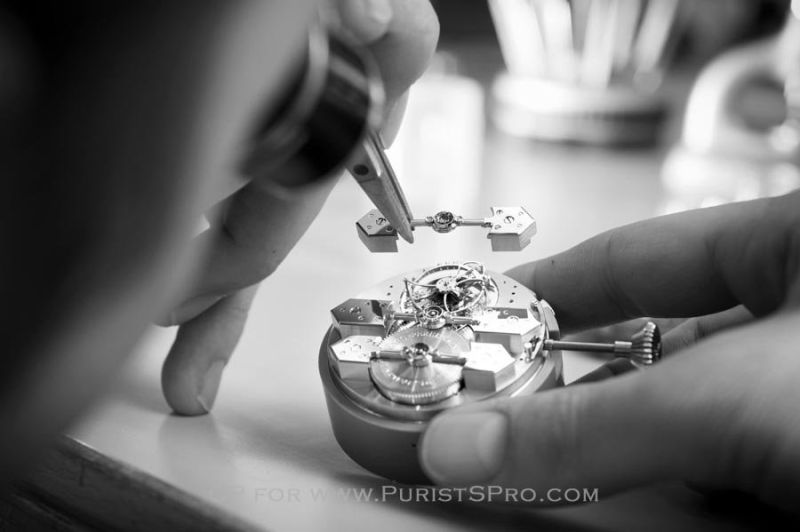
CHRONOMETER CERTIFICATION
As was the practice in the 19th Century, the rate of the Tourbillon with three gold Bridges was tested by an independent external body, and therefore bears the title of Chronometer, awarded by the COSC.
The tests are performed over a period of 15 days in a row, with the movement placed in 5 positions (6, 3 & 9 o'clock, dial up and dial down), and subjected to three temperatures (8°, 23° and 38°C). In particular, the average rate, average rate variation, differences for each position and temperature are measured and subjected to strict criteria.
The Tourbillon with three gold Bridges obtained outstanding results: over the 15 days, the mean daily rate variation was 0.1s/d. Most spectacular is the variation of rate per 1° centigrade: 0.03s/d/ °C! This is a master achievement especially in light of the use of a bimetallic balance.
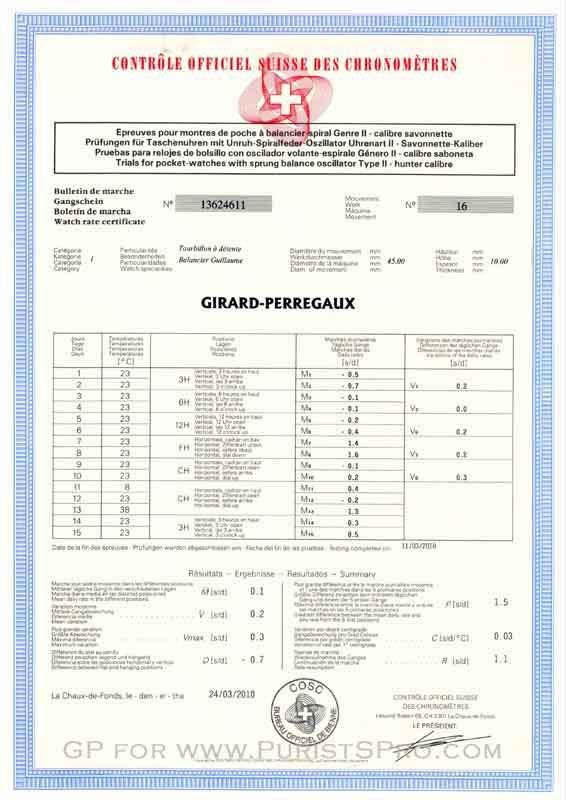
CASING
The solid pink gold hunter style case has a built-in secret mechanism for opening the dial side cover.
Pressing the push-piece situated on the crown opens the dial side cover to enable an immediate time reading.
The movement is also protected by two covers: one outer and the other inner, which features an engraving reiterating the piece's heritage.
We must note the exceptional hand-engraving work of the text, which comprises three different fonts and three different text sizes.
True to the tradition of classic Girard-Perregaux pocket watches, the dial is made from white enamel. The hour is shown by Breguet-style Arabic numerals, with a dial-train running around the dial rim to indicate the minute.
The small seconds are shown at 6 o'clock on an overlaid sub-dial, which also has a dial-train for reading the seconds. As on many old pocket watches, "60" is marked in red.
The hour and minute are displayed by long Breguet-style blued steel hands.
To make the watch absolutely unique, and in line with practice in the 19th Century, the case can be personalised according to the customer's desires.
Each case cover can be decorated with different finishes on the inside and outside, with engravings or guilloche work for example.
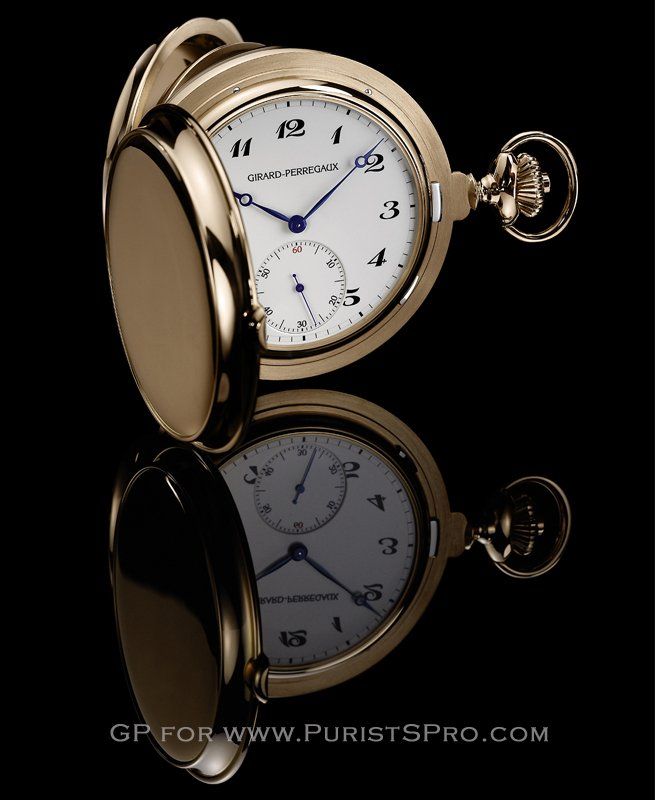
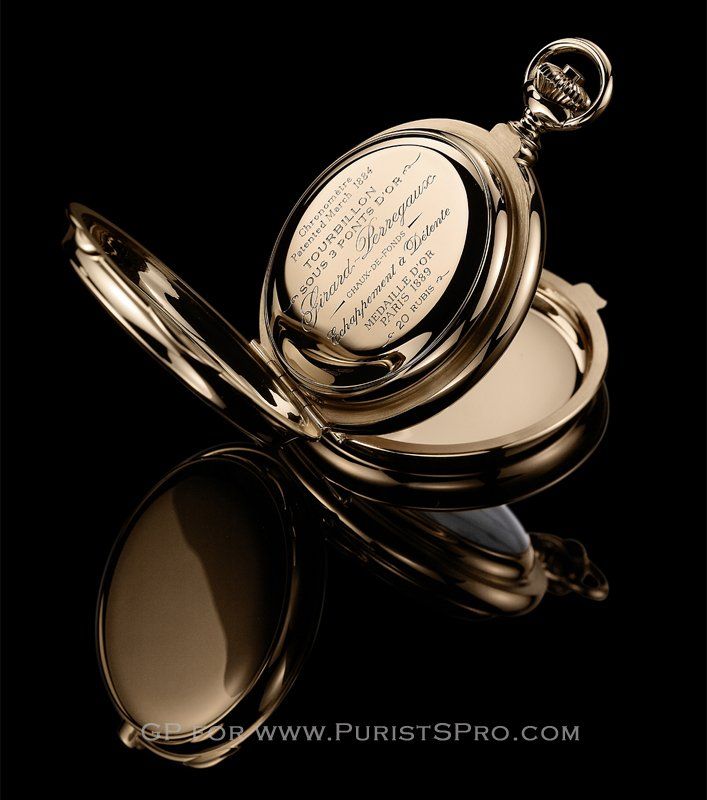
TECHNICAL INFORMATION
MOVEMENT
|
Movement dimensions |
Diameter: 45.00 mm Height: 10.00 mm |
|
Number of components |
Complete movement: 249 components Tourbillon cage: 92 components |
|
Jewelling |
20 jewels |
|
Power reserve |
32 hours (locked by Maltese Cross stopwork) |
|
Barrel |
Nickel silver drum with guilloche and hand-engraved finish, with 5N pink galvanic coating in the engraving |
|
Escapement |
Pivoted detent with gold spring; hand-honed, bevelled and drawn out; rounded-off arms and bevelled counterpoise with polished sink Hand-honed gold escapement wheel, rounded-off arms |
|
Balance |
Bimetal Guillaume compensator with anti-tripping pin 16 gold compensation screws - 2 gold setting screws |
|
Frequency |
21,600 vibrations/hour (3 Hz) |
|
Balance spring |
Breguet with anti-tripping safety pin Phillips terminal coil |
|
Main plate |
Nickel silver, hand snailing, polished corners, circular-grained and bevelled recesses |
|
Bridges |
Three gold arrow-shaped bridges; bevelled, rounded-off and hand-polished (inspection under 10x magnifier) 3 gold settings held by screw-in washers |
|
Gear trains |
Gold wheel plates, bevelled and mirror-polished on both faces Pinions with polished wing faces and stems Wings polished on wooden wheel Burnished pivots, with polished and domed pivot ends |
|
Tourbillon |
One rotation per minute Upper and lower cages bevelled and mirror-polished on both faces Cage balanced with 2 gold screws Escapement bridge, wheel bridge and detent bridge bevelled and polished A/R hand engraved |
|
Screws |
Heads bevelled and mirror-polished Screw ends polished and domed |
|
Steel parts |
Drawn out and bevelled |
|
Display |
Hour and minute Small seconds at 6 o'clock |
|
Certification |
COSC Chronometer |
EXTERIOR
|
Case materials and finishes |
Hunter case Pink gold Bolt mechanism enabling time setting (at 4.30 on the dial side of the bezel) Secret mechanism actuated by the coaxial push-piece on the crown for opening the dial side cover Hand engraving on the inner cover |
|
Case dimensions |
Diameter: 60 mm Height: 20 mm |
|
Crown |
Gold, fluted, with built-in coaxial push-piece for opening the time cover |
|
Dial |
White enamel on copper base with enamel painted Arabic numerals Overlaid enamel small seconds counter at 6 o'clock |
|
Hands |
Breguet-style blued steel hour and minute Blued steel small seconds |
PRESS RELEASE










Next Article
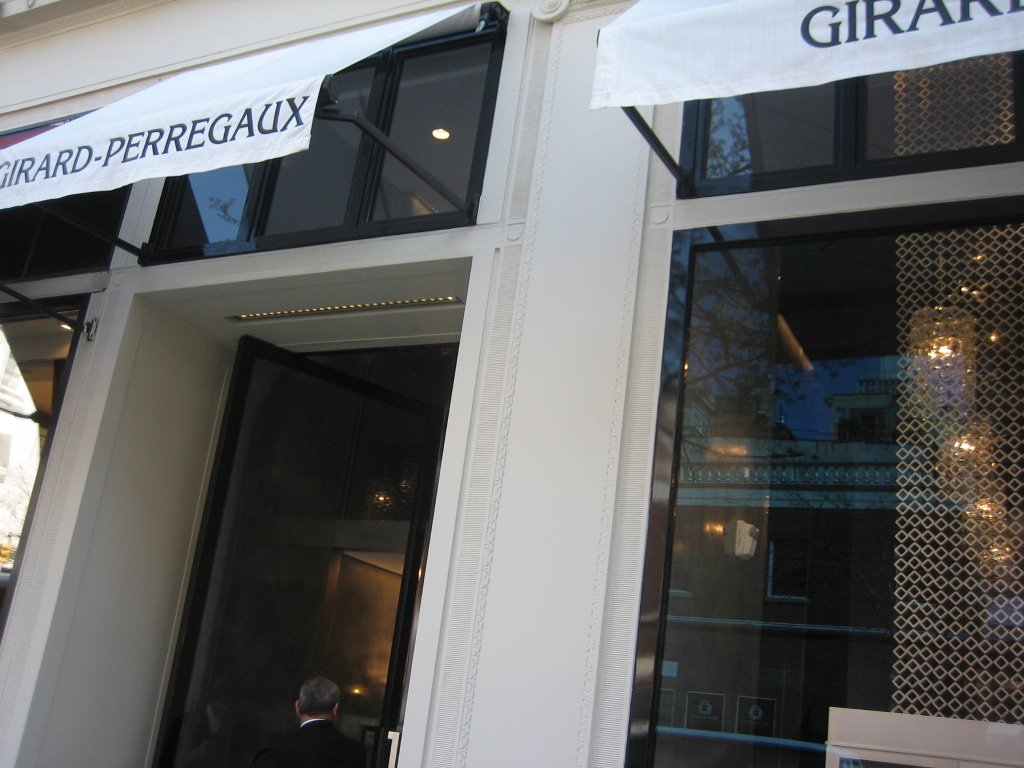

A Visit to the Girard Perregaux Flagship Boutique in New York

© 2017 - WatchProZine